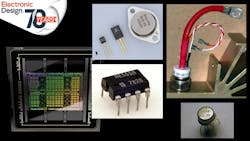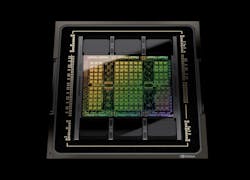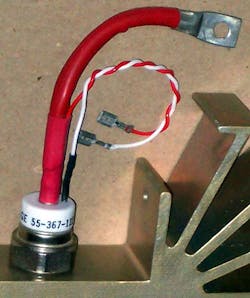70 Years of Semiconductors
This article is part of Electronic Design's 70th Anniversary series.
What you’ll learn
- What semiconductors were like 70 years ago.
- How semiconductor technology has changed over the years.
Electronic Design has been around a bit longer than I have worked in the industry—but not by much. Having lived through it, you might think I had a good handle on how the technology progressed. However, so much has happened over the years that’s been amazing even to me.
Silicon and germanium transistors have been around since the 1950s when vacuum tubes were king (Fig. 1). There were metal-oxide-semiconductor field-effect transistors (MOSFETs) in 1959, starting with p-type MOS (PMOS) and n-type MOS (NMOS) logic and eventually complementary metal-oxide-semiconductor (CMOS).
Silicon has been the mainstay since the early ’60s, bumping germanium out of the way over time. There also are some very broad areas, including digital, analog and power, when it comes to semiconductors. Optoelectronics should be in the mix, too, but that’s yet another area of discussion.
To give an idea of the growth of semiconductors over the years, just take a look at the number of transistors being packed into a single die:
- 1960: small-scale integration (SSI): < 100 transistors
- 1964: medium-scale integration (MSI): 100-1,000 transistors
- 1972: large-scale integration (LSI): 1,000-100,000 transistors
- 1980: very-large-scale integration VLSI): > 100,000 transistors
- 1989: ultra-large-scale integration (ULSI): over million transistors
- 2022: No acronym: NVIDIA Hopper H100 GPU, 80 billion transistors, 4-nm process
I haven’t been able to track down what year it might be, but more transistors are packed into one NVIDIA Hopper than were produced in the entire world at one point (Fig. 2).
The progression on the analog and power side is no less impressive. In addition to transistors, we have devices like thyristors, silicon-controlled rectifiers, and TRIACs that build on the advances in semiconductor technology (Fig. 3).
Integration and advanced semiconductor technology led to the Fairchild µA741 operational amplifier (op amp) in 1968 (Fig. 4). It simplified analog system design while providing flexibility and ease of configuration. Op amps remain a primary tool in analog designers’ kits.
The release of Signetics’ NE555 timer (Fig. 5) in 1972 was yet another stepping stone along the way to more powerful analog semiconductors. It changed the way engineers thought about timing. CMOS versions are still in use today.
Wide-bandgap (WBG) semiconductors include silicon carbide (SiC) and gallium nitride (GaN). GaN started a bit late, around 1969. The first GaN metal semiconductor field-effect transistors (GaN MESFETs) were developed in 1993. A 1-kW dc-dc converter the size of a postage stamp is possible now because of GaN FETs. Applications like electric vehicles and cloud data centers are pushing the limits for WBG technology.
More Modern Movement
LEDs and optoelectronics are yet another semiconductor technology area that has seen rapid change. They drive computer displays rather than the CRTs and vacuum light bulbs that illuminated our lives of the past. Our fiber communication systems are lit by this technology.
Semiconductor production technologies like bulk substrate, metal-organic vapor phase epitaxy, and molecular beam epitaxy have helped to deliver more compact, more powerful solutions. The demands on the production side have led to large foundries moving even large companies to being fabless suppliers.
Likewise, chip packaging also has radically changed over time. Mixing different technologies is now more common, and it’s occurring at the die level with various architectures for stacking, packing, and connecting dies within the same package.
Keeping track of what has happened in the semiconductor market in the last few months keeps me busy and amazed to the point where I often forget how much has changed over the years. It’s taken an enormous effort to get where we are today, with many fantastic products and technologies requiring millions of people to deliver. We continue to move faster as the tools and infrastructure augment what individual designers and engineers can build. Where will we be in another 70 years?
Read more articles in Electronic Design's 70th Anniversary series.
About the Author
William G. Wong
Senior Content Director - Electronic Design and Microwaves & RF
I am Editor of Electronic Design focusing on embedded, software, and systems. As Senior Content Director, I also manage Microwaves & RF and I work with a great team of editors to provide engineers, programmers, developers and technical managers with interesting and useful articles and videos on a regular basis. Check out our free newsletters to see the latest content.
You can send press releases for new products for possible coverage on the website. I am also interested in receiving contributed articles for publishing on our website. Use our template and send to me along with a signed release form.
Check out my blog, AltEmbedded on Electronic Design, as well as his latest articles on this site that are listed below.
You can visit my social media via these links:
- AltEmbedded on Electronic Design
- Bill Wong on Facebook
- @AltEmbedded on Twitter
- Bill Wong on LinkedIn
I earned a Bachelor of Electrical Engineering at the Georgia Institute of Technology and a Masters in Computer Science from Rutgers University. I still do a bit of programming using everything from C and C++ to Rust and Ada/SPARK. I do a bit of PHP programming for Drupal websites. I have posted a few Drupal modules.
I still get a hand on software and electronic hardware. Some of this can be found on our Kit Close-Up video series. You can also see me on many of our TechXchange Talk videos. I am interested in a range of projects from robotics to artificial intelligence.






